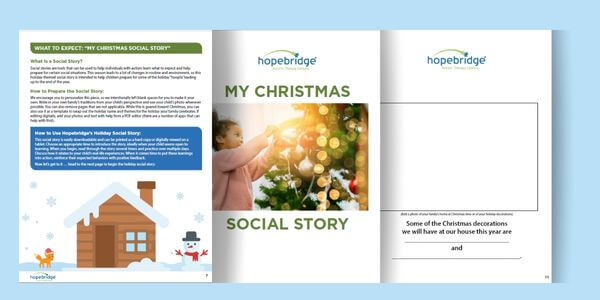A Christmas Social Story for Children with Autism
December 12, 2022
December 12, 2022

It’s beginning to look a lot like Christmas … and we bet we’re not the only ones noticing the changes. Kids – and especially those with autism spectrum disorder (ASD) – are spotting the colorful lights lining the tops of neighbors’ houses, the bell-filled music lingering in stores, and the scents of cinnamon and sugar cookies permeating in their families’ homes.
Some will be ecstatic about the idea of Santa leaving presents under the tree or unwrapping days’ worth of gifts. Others will be nervous about the idea of sitting on a stranger’s lap, overwhelmed by visiting a cousin’s Christmas party, or all too excited by the idea of so many presents and treats. Others might be unfazed by the added stimuli but have a difficult time with changes in schedule and events that often comes with holidays.
Are you uncertain about how your child will react to all the newness and changes this season, or do you just want to give them a chance to understand what’s ahead? As part of our holiday-focused content, we created a Christmas social story to help share what to expect.

Social stories are tools that can be used to help individuals with autism learn what to expect and help prepare for certain social situations.
“One of the reasons social stories are beneficial is because they can be used as part of a proactive strategy for parents with children on the spectrum,” said Hopebridge Center Manager Dominique Casarin of our autism therapy center in Aurora, CO.
This season leads to a lot of changes in routine and environment, so our holiday-themed social story is intended to help children prepare for some of the holiday “hoopla” leading up to the end of the year.
“Children with autism may experience discomfort or unease when it comes to changes in schedule or a lot of new components in their environment introduced all at once—trees, lights, decorations, more people around. It can be helpful for them to see and learn about these things to prepare ahead of time for what to expect during this time of change and new activities.”

Even if your family does not celebrate Christmas, there are elements from this social story that can be helpful for your child. Communities filled with twinkling lights, crowded stores, Santa sightings and other changes in routine are often part of the winter season, so it’s a good idea to prepare your child for the additional stimuli and transitions if you think they could pose challenges, even if they will not appear within your home.
“The value in social stories is being able to prepare and walk the child through an experience that might be overwhelming or scary for them. The preparation component of the story is key,” said Hopebridge Clinical Director Leigh Zucker in Colorado.
Choose an appropriate time to introduce the story, ideally when your child seems open to learning.
“We recommend that families or clinicians present a social story with an adequate amount of time to prepare before the event,” said Leigh. “For instance, it’s not best to read a story about going to look at Christmas lights for the first time only the day before the event.”
When you begin, read through the story several times and practice over multiple days. Role play and discuss how it relates to your child’s real-life experiences.
“I encourage parents to make it fun for their kiddos to read,” said Dominique. “If they are attending to the story or engaging with you while the story is being read, give a lot of praise. If you can, make them a part of the planning process and give them choices whenever possible.”
Then, when it comes time to put these learnings into action, reinforce them with positive feedback, even if not everything goes as planned.
Looking for more ideas this time of year? Check out our autism-friendly holiday tips on the blog, or reach out to us to talk about how Hopebridge Autism Therapy Centers can support these types of goals all year round through applied behavior analysis (ABA therapy) and other complementary therapies.
*Informed consent was obtained from the participants in this article. This information should not be captured and reused without express permission from Hopebridge, LLC. Testimonials are solicited as part of an open casting call process for testimonials from former client caregivers. Hopebridge does not permit clinical employees to solicit or use testimonials about therapeutic services received from current clients (Ethics Code for Behavior Analysts 5.07-5.08; BACB, 2020). Hopebridge does not provide any incentives, compensation, or renumeration for testimonials provided by a former client or client caregiver.
Parenting Resources
January 27, 2025
How Much Screen Time is Too Much for Children with Autism?
Parenting Resources
August 03, 2021
How Hopebridge 360 Care Prepares Kids with Autism for the Classroom
Autism in Entertainment
September 02, 2025
Building Bridges | Episode 2: 20 Years of Hopebridge